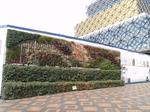 How do you grow green walls and roofs?
How do you grow green walls and roofs?
Study their design, implementation and care with this informative course. Environmental scientists, urban planners, local government employees, architects, landscape architects, landscapers, garden designers and the backyard gardener will all benefit equally from learning ways in which we can create gardens that are functional in city scapes as well as other urban environments.
Green walls and roofs can improve aesthetics by hiding ugly views, or build beautiful garden spaces in confined areas, cool buildings and reduce glare, help to improve air quality in city environments, and give people the opportunity to grow food in the city.